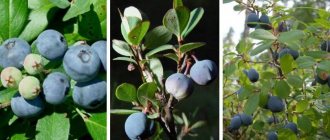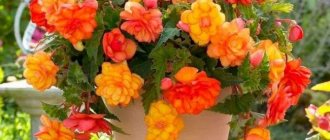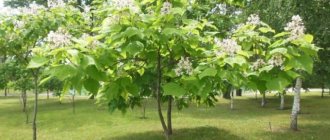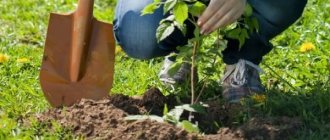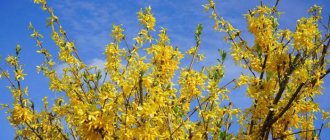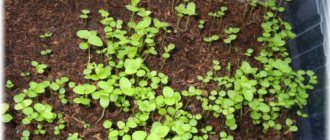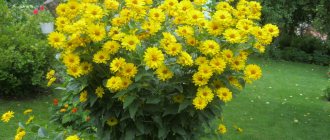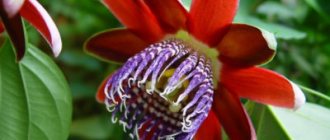Introduction
Lingonberries contrast sharply with their bright color against the background of green foliage.
Lingonberry is an evergreen shrub of the Ericaceae family. The Latin name for lingonberry, Vaccinium vitis-idaea, translates to “vine of Mount Ida.” This raises some questions, because, despite the fact that the mentioned mountain is located on the island of Crete, none of the ancient scientists mentions lingonberries.
Biologically, lingonberries belong to shrubs - they are low-growing (no more than 10-15 cm in height) plant forms that do not have a main trunk with highly branching, strong or even lignified shoots. The difference between shrubs and full-fledged bushes is that their buds and root shoots (which are actually intended to withstand unfavorable periods, that is, providing plants with longevity) are located on shoots lying on the ground or located close to it.
In its natural form, lingonberries grow almost everywhere in forests and tundras. It is often found in peat bogs, mountain meadows and also in mountain tundras. The frost resistance of the plant is quite high (zone 4, bushes tolerate temperatures down to -30°C in winter without shelter).
Their appearance attracts birds and animals, which facilitates the transfer of seeds over long distances
The literature often indicates the frost resistance of the first zone (temperature -4°C), since the generative buds of the previous season die at this temperature. However, this has virtually no effect on the yield and ripening time of the crop, since in the spring these buds form anew.
Traditionally, the crop was collected from the wild. The first attempts to “domesticate” lingonberries were made starting with the second attempt in the 18th century. But a real breakthrough was achieved about 60 years ago, when agricultural technology was developed that made it possible not only to grow lingonberries in gardens, but also to increase the yield of the crop by 20-30 times compared to its natural indicators. Currently, with proper care, one hundred square meters of cultivated lingonberries can produce more than 50 kg of berries per season.
The article discusses the issues of planting and caring for lingonberries at home, as well as ways to increase crop productivity, allowing you to get closer to industrial indicators.
How to collect and save
The leaves are collected in the spring before flowering or in the fall. The procedure can be repeated only once every five years. It is necessary to pick only those leaves that have already overwintered. They do not turn black and remain green even after drying. To obtain medicinal tea, you need to properly prepare the raw materials. The leaves should be dried in one layer, spread on horizontal surfaces, in a well-ventilated area. The color of the raw material remains green even after loss of moisture.
The berries should be picked only when they are fully ripe. They are cleaned and washed. You can make preserves and compotes from lingonberries, and make jam. It can also be frozen and stored in the refrigerator. It is necessary to seal the berries in airtight bags so that they do not become saturated with foreign berries.
Lingonberries promote better digestion, so they are served with meat. Its delicate, pleasant taste will be a piquant addition to any dish.
Lingonberries are easy to grow in your garden if you follow all the planting and care rules. The plant produces delicate, beautiful blooms in the spring and healthy berries in the fall. In one bush, gardeners acquire garden decoration and a storehouse of useful vitamins.
Description of the plant
On the shoots, flowers are collected in racemes of 10 to 20 pieces each
Lingonberry has a creeping rhizome and ascending shoots 10-20 cm high. The rhizome is located horizontally in the near-surface zone.
The roots of lingonberries are densely entwined with the mycelium of a fungus that lives in symbiosis with the plant. No matter what conditions lingonberries grow in, they always coexist with a fungus, the spores of which are contained inside the seeds of the plant.
The leaves of the plant are located alternately on the shoots. They have a leathery texture and a slightly elongated elliptical shape.
The leaf length is from 5 mm to 3 cm, the width is no more than 1.5 cm. The color of the leaves is dark green on top and lighter below. There are small dimples on the underside of the leaf that can accumulate water.
The fruits, which are red spherical berries, can have a diameter of up to 18 mm
They are equipped with short pedicels. The flowers are bisexual, four-leafed. The petal size is 5-6 mm. Flowering begins in late spring and lasts 2 weeks.
They contain several seeds and a relatively large volume of pulp. The taste of hearths is sweet and sour. Ripening occurs in August-September.
The plant is a real long-liver. Each rhizome lives from 15 to 25 years, and dead parts are regularly replaced with new ones. Cases have been recorded of the existence of lingonberry plots with a single root system that has existed for more than 100 years.
Pest and disease control
If mistakes are made during planting or care recommendations are ignored, lingonberry bushes can be affected by diseases and harmful insects. The main diseases of this berry crop are:
- Exobasidiosis : leaves turning pinkish or whitish; strong growth of foliage; damage to stems, peduncles, flowers. Prevention and treatment: spraying three times with Bordeaux mixture: before flowering, at the end of flowering, 2–3 weeks after the second treatment; prophylaxis with the drug “Rovral” (0.1%): before and after the growing season; treatment with “Euparen”, “Benomil”.
- Mycospheriliosis: formation of reddish spots on the leaves. Prevention and treatment: Three-time spraying with Fundazol and Topsin with intervals of 1–1.5 weeks.
- Sclerotinia: mummification of fruits. Prevention and treatment: Application of “Topsin” (0.2%), “Euparen” (0.2%): 3 times before flowers bloom at intervals of a week, 3 times after harvesting; use of Bordeaux mixture: before and after the growing season.
- Rust: the formation of brown spots on foliage. Prevention and treatment: Bordeaux mixture is used to prevent infection in spring and autumn; For prevention, a 1% solution is suitable, for treatment - a 3% solution.
- Monoliosis: drying of stems; deformation of shoots, leaves, flowers. Prevention and treatment: the same measures as for mycospheriliosis.
- Gibber spot: the appearance of a black crust on ground organs; drying out of the plant. Prevention and treatment: treatments with Fundazol, Topsin, Bordeaux mixture.
The greatest danger to the growth and development of lingonberries is posed by the following insects:
- Leaf roller. The butterfly caterpillar is yellow-brown in color. Colored gray-green or yellow-green. Symptoms of infection: damage to buds, buds, ovaries, leaves; rolling leaves into a tube. Prevention and treatment: spraying with decoctions of tomato tops, wormwood, onions, garlic; three-time treatments with insecticides “Karate”, “Decis” during the formation of buds with an interval of 1-3 weeks.
- Aphid. A miniature sucking insect with body dimensions up to 0.6 mm. It can be green or black, with or without wings. It feeds on plant juices. Symptoms of infection: yellowing, curling, drying of foliage; the appearance of honeydew on ground organs; stopping shoot growth. Prevention and treatment: timely removal of ants that carry aphids from the area; treatment of ground organs with soap solution; use of "Rogora", "Aktellika".
- Leaf beetle A small or medium-sized beetle with a body size of 3–15 mm and bright coloring. Symptoms of infection: leaves eaten away to the veins. Prevention and treatment: Use of onion, dandelion, tobacco infusions; treatment with “Aktellik”, “Phosbucid”, “Kemifos”.
- Shield. A small gray insect with a hard shell. It feeds on plant juices. Symptoms of infection: the appearance of dark spots on ground organs; drying out of the plant. Prevention and treatment: use of drugs “Karbofos”, “Aktara”, “Tanrek”; spraying with coniferous or citrus tincture.
Using lingonberries
Open lingonberry pie with sour cream
Lingonberries are widely used in cooking. They contain up to 10% sugars, so lingonberries are used to make preserves, jams, compotes, etc. Despite the relatively high concentration of sugars, the calorie content of the berries is about 43 kcal per 100 g, which is slightly higher than that of blueberries (35 kcal), but less than that of raspberries (53 kcal).
Lingonberry pies, various sweet and sour sauces and the legendary lingonberry water (a cold drink made from lingonberries and honey, obtained by infusing for several days) are popular.
The healing properties of lingonberries are due to the vitamins and minerals it contains. The berries contain the most vitamins A and C. Microelements include chromium, potassium and magnesium.
Drinking a decoction of lingonberry leaves is used as an adjuvant therapy in the treatment of colds.
The substances contained in the berries and leaves (in particular benzoic acid) have a disinfectant, antiseptic and diuretic effect. In addition, lingonberries are recommended to be consumed to increase stomach acidity and disorders of the cardiovascular system.
In addition, lingonberries in various forms are recommended to be consumed for preventive purposes in winter in order to avoid the consequences associated with vitamin deficiency.
Properties of lingonberries - harm and benefit
Beneficial features
The medicinal properties of lingonberries have been known for a long time: our great-grandfathers called it “the berry of immortality” because it cured many ailments. The berry is valuable primarily for its high content of vitamins A, E, B and C. The composition of lingonberry fruits also includes organic acids (citric, malic, oxalic, benzoic and salicylic), minerals such as manganese, magnesium, potassium, iron , calcium and phosphorus, as well as starch, mono- and disaccharides, flavonoids and other substances necessary for the human body.
Interestingly, the beneficial properties of lingonberry leaves are valued no less than the properties of the berries: they also contain a whole range of important substances, and first of all, the natural antiseptic arbutin. Today, lingonberry leaves are used for medicinal purposes even more often than its fruits. This is due to the fact that they are easier to harvest, transport, and they are stored longer than berries without loss of quality. Lingonberry leaves have a tonic, anthelmintic, antipyretic, wound-healing, tonic, antiscorbutic, laxative, diuretic, choleretic, diuretic and disinfectant effect.
Lingonberry is an excellent assistant in the treatment of coronary heart disease due to the content of chromium, copper and mineral salts in its berries. It lowers glucose levels and is recommended for people with high blood sugar. Lingonberries are indicated during pregnancy: its juice is taken for neuroses and anemia, which often accompany women during this period. The use of lingonberries at low acidity of gastric juice has a beneficial effect on intestinal motility.
Plant preparations are popular in folk medicine: a decoction of lingonberries quenches thirst during fever, and a decoction of its leaves is taken for diabetes, kidney disease, gout and rheumatism. Lingonberry tea (lingonberry leaves brewed with boiling water) relieves fatigue and restores strength.
- Whitewashing trees in spring: how and what to whitewash trees with
It has been proven that lingonberries enhance the effect of sulfa drugs and antibiotics, so lingonberry juice is prescribed for fevers and to increase appetite after a serious illness.
Contraindications
Contraindications for lingonberry leaves apply to children under 12 years of age and people with high acidity of gastric juice. In addition, hypotensive patients should take lingonberry leaf preparations with caution and for no longer than 2-3 weeks, after which they should take a break for 2 weeks. This is due to the fact that due to the strong diuretic effect of the drug, blood pressure can drop sharply.
As for lingonberry berries, it is undesirable to use them for gastritis with high acidity and stomach ulcers, and due to the thinning properties of lingonberry preparations, they are contraindicated for postoperative patients and patients with internal bleeding.
Lingonberries have one bad property: they, like no other plant, are capable of accumulating radioactive and toxic substances, so you can only eat berries that grew far from roads, cemeteries and industrial production.
Lingonberry varieties
Selection work on the crop began about a hundred years ago
Currently, there are about a dozen varieties of lingonberries recommended for growing in the country or in a personal plot. Thanks to the work of breeders, unlike its wild ancestor, garden lingonberries have larger berries and better taste.
Below are descriptions and photographs of the most popular varieties recommended for planting in the garden.
Coral
Coral
Coral One of the old remontant varieties of European selection, obtained in 1969 in Germany. It is considered the first domesticated variety capable of producing two harvests per season. It blooms for the first time in May and bears fruit in July. The second flowering begins immediately after fruiting, the berries ripen by the end of September.
This variety of lingonberry has an extraordinary appearance (a spherical crown with a diameter of up to 30 cm), therefore it is often used as an ornamental plant. The berries are small in size, but due to two fruitings the yield is maintained at a sufficient level.
Mazovia
Mazovia
Mazovia A large-fruited variety with an average length of shoots (up to 20 cm). The plant is creeping and densely branched. The leaves have a convex shape. Due to its density, it is often used as a ground cover plant.
The weight of the fruit reaches 0.5 g, with dimensions of 15-17 mm. The skin color is pink-red. The taste is sweet with medium sourness.
Kostroma pink
Kostroma pink
Kostroma pink Variety of domestic selection, bred in 1995. The bush is medium-sized, up to 20 cm in height. It has medium-sized leaves with a clearly visible gloss.
The clusters consist of 4-5 berries with a diameter of 10-12 mm weighing up to 0.5 g. The skin is pink in color. The taste is sweet and sour, there is practically no aroma. Kostroma pink ripens in mid-August. Productivity is relatively low - up to 380 g per 1 sq. m.
Ruby
Ruby
Ruby A late-ripening variety that bears fruit at the end of August. It is not self-fertile, that is, for high productivity it requires the presence of several bushes of other species on the site. Bred in 1998, at the same time it was entered into the State Register for the North-Western region.
The height of the plant reaches 20 cm. The bush is compressed, the shoots are of medium thickness. The foliage of the stems is dense, which allows the crop to be used as a ground cover plant. The size of the berries reaches 12-15 mm, the skin is dark red or burgundy. The taste is sweet and sour. Yields of the Ruby variety reach 970 g per 1 sq. m.
Red Pearl
Red Pearl
Red Pearl The tall Red Pearl variety was bred in Holland specifically for commercial cultivation. Its main advantages are self-fertility and the ability to produce two crops during the season.
The height of the bush is quite large - up to 30 cm. Moreover, the bush has a wide spreading crown, which should be taken into account when choosing a planting scheme. The fruit size is up to 12 mm, their color is burgundy. The stems of the plant are densely strewn with berries.
A special feature of the variety is its high winter hardiness and immunity to return frosts. Red Pearl bears fruit in late summer - early autumn.
How to properly plant lingonberries on a plot
Even an inexperienced beginner will not have any difficulties in growing lingonberries; the crop is extremely undemanding. If you properly prepare the soil and follow the basic recommendations, the bushes will delight you with rapid growth and fruiting.
See also
Description and characteristics of the Elizabeth blueberry variety, planting rules and careRead
Required soil composition
Under natural conditions, the bush densely occupies peat bogs and marshy areas. Be sure to ensure that the soil for the plant is acidic or peaty. Heavy loams are not welcome; lingonberries can die.
The best soil composition for lingonberries:
- peat;
- a small amount of sand;
- garden soil.
The amount of peat should predominate in the mixture, this will affect the size of the fruit.
Best place to drop off
Lingonberry is a light-loving plant. The area in the dacha for growing bushes should be in a sunny place. Be sure to take care of the absence of groundwater; an abundance of water will lead to rotting of the roots and death of the plants. It is better not to grow the crop in the shade of large trees on a personal plot; flowering and fruiting will be poor.
Planting dates and technology
It is better to plant lingonberries in the fall, before the onset of stable cold weather. It’s better to hurry, the plants must have time to take root in order to survive severe frosts without loss. Spring planting is recommended for residents of cold regions.
Plant the bushes at a distance of 25-30 cm. Also make the row spacing small - up to 30 cm. Be sure to water the lingonberries generously after planting. A mulching layer - with conifer needles or crushed bark - would be useful. Mulch will both protect and increase the acidity of the soil, which is necessary for plants.
Selection and preparation of a site for planting lingonberries
In this case, the soil mixture can be prepared directly in the formed depression.
To grow lingonberries in the garden, you should know the physiology of the plant. The culture prefers sunny and well-lit places. It makes no sense to plant a crop in an area where it will be dark. The soil at the planting site should be poor and dry.
The soil acidity level should be very high (pH ranging from 5.0 to 3.0). In soils with less acidity, the plant simply will not be able to exist, since it will not be able to absorb nutrients from the soil.
Another important requirement for the site is the absence of slopes, lowlands and holes. Simply put, the area where you plan to grow garden lingonberries must be level. All this is necessary in order to avoid the possibility of flooding of individual beds, since unlike their closest relatives - cranberries and bearberries, lingonberries require dosed watering with a moderate amount of water. Wind protection is not required.
To ensure such conditions in summer cottages, it is necessary not only to level their surface, but also to use a special soil mixture.
In some cases, complete isolation of the soil mixture on the site is used by creating a separate container or forming a trench into which a plastic film is placed so that the lingonberry soil does not come into contact with the soil on the site
The optimal soil for lingonberries will be sandy. In principle, in this case you don’t even need to add any additives to it, except peat.
If the composition of the soil is different, you will have to make some efforts to provide the plant with the necessary conditions for garden planting.
To do this, the following components should be added to the dug soil, taken in equal proportions:
- peat
- sawdust
- pine needles
- sand
You will need a lot of components, because the mass of each of them must be equal to the amount of soil dug up. Their introduction will lead to an increase in the height of the site by about 20 cm. You can grow berries this way, but it is somewhat inconvenient, in particular, it will be difficult to acidify the soil in such a structure.
To ensure that the plot for lingonberries is level with the rest of the garden, it is recommended to make it in a recess, having first removed the top layer of soil and moved it to a separate place. The more fertile top layer may be useful for other purposes.
Garden colloidal sulfur is sold in different packaging from a few grams to 5 liters
There is no need to apply additional mineral or organic fertilizers, since peat contains a sufficient amount of nutrients. The only component required to grow lingonberries is sulfur. Its application rates are 50 g per 1 square meter. m.
Typically, the area for growing lingonberries is located separately from the rest of the garden. Moreover, the concept “separately” should be taken literally.
Such isolation of lingonberries is necessary so that soils of different compositions do not affect each other. For other crops, the substrate will be too aggressive; at the same time, without isolation, the acidity of the lingonberry soil will constantly decrease due to its erosion. But even such isolation is not enough to ensure the necessary soil acidity.
If a decision is made not to isolate the site, it must be remembered that this is only permissible in those places where the groundwater level is no higher than 40 cm. But even with such a bed design, it is recommended to install plastic, slate or simple boards around the perimeter of the site boards to a depth of about 30 cm.
The resulting soil mixture will need to be acidified. To do this, use a composition of 100 g of citric acid per 3 liters of water; alternative - 200 ml of apple cider vinegar per 10 liters of water. Application rate – 10 liters per 1 sq. m.
After the soil has been prepared, planting begins.
Lingonberry collection and storage
As a rule, lingonberries are harvested in August and September, after the fruits are fully ripe. Since the berries contain a large amount of benzoic acid, they can be perfectly stored throughout the winter period; for this, they are placed in containers made of ceramic or wood, which are filled with weak sugar syrup or water. Canned or dried fruits last much longer. Frozen berries also store very well. To do this, washed ripe fruits need to be dried and, after distributing them into containers or polyethylene bags, put them in the freezer.
LINGONBERRY - SEARCH, COLLECTION, CLEANING, SUGARING. PREPARATION RECIPE – SÜF KRASNODAR
Planting lingonberries
As soon as moisture is absorbed into the substrate, the surface should be mulched
It is best to plant lingonberries correctly in the off-season - a month before flowering or 1-2 weeks after harvesting (respectively, at the end of April or mid-September). For planting, one- or two-year-old seedlings are used, which are placed in shallow (up to 2 cm) holes. It is believed that spring planting will allow the seedlings to perfectly adapt to the new location, which will have a positive effect on the health of young plants.
Depending on the goals pursued by the gardener (purely fruitful crop or partly fruitful, partly decorative), different distances between the holes are chosen.
In the first case, the plants are planted according to the scheme 30x30 cm or 30x40 cm. In the second - 20x20 cm. Decorative planting does not provide the required yield, but allows you to create a continuous carpet of lingonberries, which has a very impressive appearance. Already in the first year, the plant begins to actively grow and the crowns of the bushes quickly grow together, forming a thick covering.
After the plant is planted, it is necessary to compact the area and water it.
The best mulch option would be crumbled bark from coniferous trees (spruce, pine). You can simply fill the area with chopped pine needles. The height of the mulch layer is from 2 to 5 cm, depending on the growth of the seedlings. Not only will mulching protect the topsoil and provide weed control, but it will also provide some additional acidification to the area.
It is recommended to loosen the soil to a depth of 2 cm before mulching.
Blueberries and lingonberries: planting and care
The soil for planting these shrubs should be light, sandy loam or peaty, with a high level of acidity. Moreover, you can plant the plant in any area, even the most unsuitable for planting, by pouring a 30-centimeter layer of sand with added peat and sawdust. Planting lingonberry seedlings and caring for plants is carried out mainly in spring (April–May) or autumn. The seedlings are buried approximately 2 cm into the soil. It is advisable to plant lingonberries at a distance of 30 cm from each other in a row with a row spacing of 40 cm. This is convenient for both manual and mechanized berry picking. The main thing is to prepare high-quality planting material, and planting lingonberries will not cause much trouble. The principle of planting lingonberries and blueberries is the same. In flower beds and beds, shrubs can be planted every 20 cm to completely connect their crowns. After this, the area needs to be watered to compact it and mulched with a layer of about 5 cm.
Lingonberry care
Lingonberries are relatively undemanding to care for.
The plant, which primarily grows in the wild, is ubiquitous and has strong immunity , can theoretically grow without any additional procedures. But, since the gardener needs a certain level of productivity, lingonberries require certain care.
Watering
Caring for lingonberries - watering
Watering lingonberries is carried out moderately, since the crop does not like waterlogging. The roots of the plant are located close enough to the soil, so its top layer should be slightly moist. The approximate frequency of watering is once a week. The best time for this procedure is the evening, just before sunset.
In hot weather, every second watering is recommended to be combined with sprinkling.
Since water leads to deoxidation of the soil, once every 3-4 weeks it is recommended to water the lingonberries with an acidified solution (1 tablespoon of citric acid per 5 liters of water).
Feeding
Double superphosphate
The substrate in which the crop is grown is itself quite nutritious and the supply of nutrients is enough for several years. Therefore, it makes no sense to apply fertilizers. However, once a year, about a month before flowering, it is recommended to feed lingonberries with a fertilizer mixture (superphosphate + potassium sulfate) in microdoses (2-3 g per 1 sq. m).
Mineral nitrogen fertilizers, as well as manure in any form, are strictly prohibited!
Trimming
Pruning lingonberries
When grown in gardens in open ground, lingonberries develop quite quickly and after a few years fill almost all the free space around them. If its growth is not limited, the bush may die in 10-12 years.
Therefore, once every 7-8 years it is recommended to carry out anti-aging pruning of lingonberries. To do this, at the beginning of spring, all shoots on the bush should be shortened using pruning shears. It would be most correct to prune in such a way that 4-6 leaves remain on the shoots. Often, anti-aging pruning is combined with medicinal collection of lingonberry leaves.
Shelter for the winter
Winter shelter for lingonberries
Despite the fact that lingonberries tolerate the cold season relatively well (most varieties of the plant can withstand frosts down to -30°C), in regions with little snow, it is recommended to cover the plant with at least a minimal layer of heat insulation.
Usually, it is enough to cover the beds with one layer of agrofibre. If there is a lot of snow in winter, the crop does not need shelter.
Protection from diseases and pests
leaf roller
Lingonberries themselves have very good protection against pests and diseases. In cultivated plantings, the probability of diseases is almost zero. However, for prevention against fungi, it is recommended to spray the crop twice a season (one month before and one month after flowering) with copper-containing preparations (for example, Bordeaux mixture) in low concentration.
Sometimes the plant can be attacked by insects, in particular leaf rollers. It is recommended to periodically inspect the bushes to identify pests. If they are detected, broad-spectrum insecticides are used (for example, Karbofos).
Diseases and pests of lingonberries
When growing cultivated lingonberries, a gardener most often faces the following problems:
- exobasidiosis, expressed in the growth and whitening of shoots;
- sclerotinia, which causes mummification of berries;
- moniliosis, leading to drying out of the plant.
These fungal diseases require triple treatment with Bordeaux mixture at intervals of 2-3 weeks and prevention of soil waterlogging.
Pests of lingonberries are represented mainly by leaf rollers, which gnaw young leaves, flowers and ovaries. However, due to the small areas of lingonberry plantations, pests are not widespread at present.
Lingonberries will look good on an alpine hill
Harvesting
Photo of a bucket-harvester for collecting lingonberries
Picking berries can be done manually, but this will be too slow and inconvenient. Therefore, in order to collect lingonberries, various devices are used. One of them is a harvester bucket, which is also used for collecting berries in the wild. It is a scoop with plastic or steel spikes for separating berries from the stems.
This device is very simple to use - holding it by the handle, place it 5-10 cm from the ground, approximately at half the height of the bushes. The berries are separated easily, and the leaves practically do not fall into the ladle. The traditional collection time is the end of summer.
In addition to the berries, lingonberry leaves are also collected for medicinal use. This procedure is carried out even before flowering begins, since at the end of spring and summer all the beneficial substances leave the leaves for the flowers and berries.
The leaves are harvested manually, giving preference to young blades formed this year. In this case, you should not tear off more than 1/3 of all the leaves on the bush.
Collecting leaves from a bush can be done no more than once every 3-5 years.
Cowberry propagation
Lingonberry seedling obtained by cuttings and planted in spring
You can easily propagate lingonberries on your own. Like most berry crops, it can be implemented in the following ways:
- cuttings (stem or root)
- dividing the bush
- using seeds
The latter method is rarely used because it takes a relatively long time and is mainly effective for wild varieties. However, some domesticated varieties (for example, Coral) also reproduce well using this method.
In any case, seed propagation will require long-term (up to 5 months) stratification of seeds at a temperature of 4-5°C, followed by planting them in an acidic substrate. A seedling ready for transplanting will grow only after 2-3 years. The only advantage of this method is that it obtains a practically unlimited amount of planting material.
Propagation of lingonberries by cuttings will be more effective. Typically, they are formed from shoots at least 12 cm long with 2-6 leaves. Rooting with this method of propagation of lingonberries is carried out in a peat substrate (3 parts peat and 1 part sand). On average, the survival rate of rooted cuttings is 60%. Planting of seedlings in open ground is carried out after 1.5-2 years.
The fastest way to obtain young plants, when they can be immediately planted in a permanent place and they will produce a harvest next season, is to divide the bush. Usually, fragments at least 6-8 cm long are separated from the rhizome, on which 5-8 shoots are located. They are simply transplanted to a new place according to the planting rules given earlier.
Industrial cultivation of lingonberries
Harvesting lingonberries using a berry harvester
When growing plants in large volumes, the most optimal technologies are used to maximize crop yield. Of course, at home it is difficult to recreate the entire growing process carried out in specialized farms. However, by making certain adjustments to the previously discussed planting and cultivation methods, you can achieve results comparable to professional cultivation.
The first thing you need to start with is preparing the site. In this case, a slightly different soil recipe for growing crops is used, more enriched with peat. This composition was originally used in climates with short summers to speed up the process of berry formation.
Currently, it is used almost everywhere in the industrial cultivation of lingonberries. The composition of the soil will be as follows: for each part of the excavated soil, take 5 parts of peat, 2 parts of sand and 0.5 parts of pine needles and sawdust.
The beds must be formed in complete isolation from the external soil. For this purpose, cultivation can be carried out in separate containers, or you can use the previously described method using plastic film. For ease of maintenance of such beds, it is recommended to dig a trench 20-30 cm deep and at least 60 cm wide for planting lingonberries. The length will depend on the number of plants.
For areas larger than 10-15 acres, watering using mobile systems will be more profitable
In some cases, the size of the plots can be quite large. It is commercially justified to use an area of at least 10 acres when renting mechanical means for cultivating the site and harvesting crops.
With an area of at least 30 acres, it makes sense to think about purchasing your own equipment. Naturally, the use of such areas makes soil isolation pointless - the soil mixture is formed directly on the plots.
The watering scheme will also differ from that described earlier. In relatively small areas, drip irrigation systems are used, as this will help to significantly reduce water consumption.
They can have a wide variety of forms: from homemade primitive sprinklers (in the form of a plastic container with water) on a mini-tractor to serious sprinkler systems.
Device for collecting lingonberries
Regardless of the type of irrigation system, the soil on the site during the growing season should be acidified once every 20-30 days with a 0.2% solution of citric acid (200 g per 100 l).
Harvesting is carried out using the previously described combine buckets, or using specialized harvesting equipment designed for processing berry fields. It is believed that the same cleaning products can be used to harvest lingonberries as for cranberries. In some cases, modification of the device for picking berries from branches is required, but this can be easily done independently.
